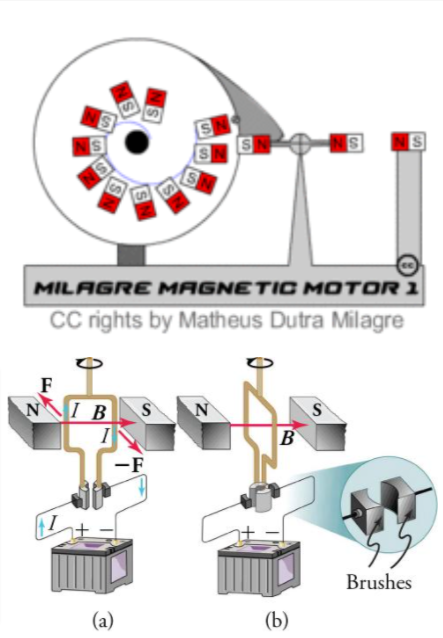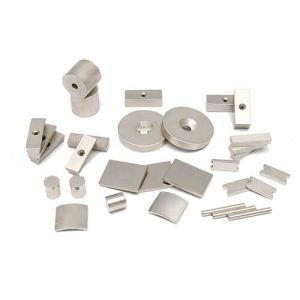Magnetism around us - Effects
Applications of Magnetostriction

Img src
When a material is subjected to an alternating magnetic field, the variation of B (or M) with H traces out a hysteresis loop. At the same time, the variation of l with H traces out another loop. The latter is actually a double loop, sometimes called a butterfly loop, as illustrated for nickel in figure, because the magnetostrictive strain does not change sign when the field is reversed. The material therefore vibrates at twice the frequency of the field to which it is exposed. This magnetostrictive vibration is one source of the humming sound emitted by transformers. (A transformer contains a “core” of magnetic material subjected to the alternating magnetic field generated by the alternating current in the primary winding.) This sound, sometimes called “60-cycle hum,” actually has a fundamental frequency of twice 60, or 120 Hz. In Europe and other countries where the ac power frequency is 50 Hz, the hum is at 100 Hz.
Conversely, if a partially magnetized body is mechanically vibrated, its magnetization will vary in magnitude about some mean value because of the inverse magnetostrictive effect, and this alternating magnetization will induce an alternating emf in a coil wound around the body.
These two effects are exploited in the magnetostrictive transducer. It is one of a class of electromechanical transducers which can convert electrical energy into mechanical energy,
and vice versa. The shape and size of a magnetostrictive transducer depends on the nature of the application. In early applications, nickel was commonly used as the magnetostrictive material, but this has been replaced by a rare earth-iron compound of the approximate composition Tb3Dy7Fe19, known as Terfenol-D, prepared by directional solidification to have a strong crystallographic texture.
Article src: Introduction to Magnetism and Magnetic Materials (1nd edition), David Jiles, Chapman & Hall/CRC, 1991.
Energy Conversion
- Electrical-to-Mechanical
If a current flows in a conductor located in the magnetic field of a permanent magnet, a force will be exerted on that conductor. This is the operating principle of such devices as the loudspeaker, permanent-magnet motor, moving-coil electrical instruments, and headpositioners for hard disk drives. In addition, motors are devices for converting electrical energy into mechanical energy.
- Mechanical-to-Electrical
If the flux through a winding is changed, an emf will be induced in that winding. The flux change can be effected by any mechanically produced relative motion of a magnet and the winding. This principle is the basis for devices like the magneto and the microphone. The magneto consists of a magnet rotating within an iron core carrying a winding. It is used to produce the sparks for ignition in small gasoline engines, such as those used in power lawn mowers and outboard motors.
The magnetic microphone is simply the inverse of the loudspeaker. It is rarely used, except in some simple communication systems where the loudspeaker also serves as the microphone.
A transformer is a device which can transfer electrical energy from one electrical circuit to another although the two circuits are not connected electrically. This is achieved by a magnetic flux which links the two circuits through an inductance coil in each circuit. The two coils are connected by a high-permeability magnetic core. The main consideration for the purpose of this chapter is the choice of a suitable material for the magnetic core of the transformer. The material used for transformer cores is almost exclusively grain-oriented silicon-iron, although small cores still use non-oriented silicon-iron. High-frequency transformers use cobalt-iron although this represents only a small volume of the total transformer market.
Generators are devices for converting mechanical energy into electrical energy. Motors are devices for converting electrical energy into mechanical energy. Both are constructed from high-induction, high-permeability magnetic materials. The most common material used for these applications is non-oriented silicon-iron but many smaller motors use silicon-free low-carbon steels.
Article src: Introduction to Magnetism and Magnetic Materials (1nd edition), David Jiles, Chapman & Hall/CRC, 1991.
Article src: Introduction to Magnetic Materials (2nd Edition), B. D. Cullity, C. D. Graham, Wiley-IEEE Press, 2008.
Fe-Based Amorphous Metallic Glasses
The conversion of magnetic to mechanical energy in amorphous Fe-based metallic glasses (e.g., a Metglas alloy of composition Fe81B13.5Si3.5C2) can be as high as 90% when the amorphous ribbons are annealed in a transverse magnetic field and then cooled rapidly. In this state the ribbons have an induced tranverse magnetic anisotropy. When placed in a longitudinal magnetic field, the domain magnetizations rotate smoothly from the perpendicular to the parallel direction, with no motion of domain walls. The rotation can be accomplished in very low applied fields due to the low anisotropy fields HK that can be achieved in these amorphous materials. The ribbons elongate due to their positive magnetostriction.
Article src: The physics and chemistry of materials, Joel I. Gersten, Frederick W. Smith, John Wiley & Sons, Inc, United States of America, 2001.
Magnetic Levitation

Img src
For centuries there had been dreams of magnetic levitation, i.e., the stable suspension in the air of a body made of iron or other magnetic material, without physical contact, by an artful arrangement of magnets exerting the proper attraction and repulsion. But such hopes were dashed in 1839 when S. Earnshaw proved that it could not be done. His theorem relates to both electrostatic and magnetostatic forces, or to any system of particles which exert forces on one another varying inversely as the square of the distance. For magnetic systems, Earnshaw’s theorem may be stated as follows: Stable levitation of one body by one or more other bodies is impossible, if all bodies in the system have a permeability greater than 1.
Stable levitation can be achieved for a positive permeability material if a position detector and feedback system are employed so that the force acting on the floating object is continuously adjusted, usually by varying the current through an electromagnet. This is the basis for various floating novelty items as well as for nearly zero-friction suspensions for various kinds of rotating instruments and machines.
If diamagnetic materials are included in the system, stable levitation becomes possible without power input. Levitation of this kind is easiest with a perfect diamagnet, namely, a superconductor. Figure shows a bar magnet floating over the slightly concave surface of superconducting lead at 4K. The magnet is in effect supported by its own field, which cannot penetrate into the lead.
The permeability of a superconductor is zero, and there are many diamagnetic materials with permeabilities slightly less than unity. But there are no diamagnetic materials with intermediate values of m, like 20.5. This means that only very light bodies, a few grams in weight, can be stably levitated at room temperature with the help of ordinary diamagnetic materials, like graphite or bismuth, because their flux-repelling powers are so feeble.
Quite large weights can be supported by the repulsion between permanent magnets, the lower one fixed to a base and the upper one to the underside of the load. Some lateral constraint is needed to make the load stable, but it need not be strong. The magnets must have high coercivity. Barium ferrite and rare-earth magnets are well suited to this application since they can be made in flat pieces of fairly large area, magnetized in the thickness direction.
Article src: Magnetism and Magnetic Materials, J. M. D Coey, Cambridge University Press, 2010.
Permanent Magnets
Permanent magnets generate stable magnetic fields without continuous expenditure of electrical energy. This is an advantage in certain circumstances. There are many different applications of permanent magnets and as we have seen considerations of geometry lead to many different materials requirements. Therefore there remains a wide range of permanent magnet materials available commercially. The main applications of permanent magnets are in electric motors, generators, loudspeakers, moving-coil meters, magnetic separators, control devices for electron beams such as in TV sets, frictionless bearings and magnetic levitation systems, and various forms of holding magnets such as door catches.
Electric motors, in which electrical energy is converted into mechanical energy, and electric generators in which mechanical energy is converted into electrical energy are the most important single application of permanent magnets. The recent neodymium-iron-boron permanent magnet material was developed by General Motors for use in the starter motors of their cars and trucks. The size of motors can be reduced greatly by the use of stronger permanent magnet materials and this is often an important consideration which outweighs the additional cost of the high-performance magnets. Neodymium-iron-boron permanent magnets are also now being used in magnetic resonance imaging systems. This application requires a very high field homogeneity, typically 5 parts per million over a volume 0.6 m in diameter.
Article src: Introduction to Magnetism and Magnetic Materials (1nd edition), David Jiles, Chapman & Hall/CRC, 1991.


